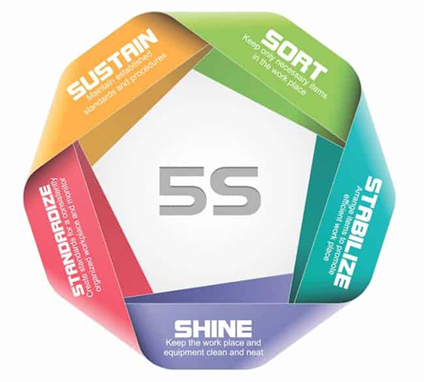5S CONCEPT
5S is a workplace organizational method that uses a list of words to describe how to organize a work space. Those words are Sort, Straighten, Shine, Standardize and Sustain. 5S was originally developed in Japan as part of Just-in-Time manufacturing techniques. Now, 5S is being applied to a wide variety of industries. It has expanded from manufacturing to healthcare, education, government, and more. The 5S Concept certification, available exclusively through the Management and Strategy Institute, will give you an understanding of 5S methodology and how it is applied in the workplace. Implementing 5S raises product quality and improves work productivity, resulting in lower costs and higher efficiencies.

History:
The 5S philosophy, sometimes written as 5s or Five S, originated in Japan as part of lean manufacturing techniques implemented at automaker Toyota following World War II. It then spread, along with other lean manufacturing practices, to companies around the globe, picking up speed in the 1990s. Over time, 5S has become part of a constellation of efficiency and waste-reduction systems that facilitate just-in-time manufacturing, including Kaizen, Kanban and Six Sigma. With its emphasis on keeping a workplace organized and orderly, it’s sometime called a clean manufacturing technique, but don’t dismiss it as simply cleaning up.
“It is not just about housekeeping but concentrating on maintaining the standards to manage the organization—all achieved by upholding and showing respect for the Gemba (workplace) every day,” explains the Kaizen Institute Consulting Group, a global consultancy based in Zug, Switzerland. Or, to put it another way, “It is a systematic and methodical approach allowing teams to organize their workplace in the safest and most efficient manner.”
The 5S philosophy refers specifically to five organizational steps that are to be done in order (Japanese terms are in parentheses):
1. Sort (Seiri)
The method starts by sorting through items in a certain area, separating what is needed from what is not. Neuwirth suggests beginning by “removing all items from your work area.” Then, he says, “inspect the equipment and identify those items that are critical to the success of the function performed at the workstation.” The 5S philosophy typically recommends tagging questionable or unnecessary items with red tags and setting them aside for a time to make sure they’re not needed. (For more on 5S tools, see story on page 38.) At the end of that period, anything that’s not needed should be—depending on what’s most appropriate—thrown away, recycled, stored or moved to another location where it is regularly used. “This saves time, space and labor costs, while enhancing productivity,” Neuwirth says.
2. Straighten, Set in Order or Stabilize (Seiton)
In this step, you organize necessary items so that they are ready for use and easily accessible. “An important objective of seiton is to reduce the nonvalue-adding activity of searching for items, tools, and documents,” explains Torbjørn Netland in a September 2015 article in LMJ magazine headlined, “5S: We Are Doing It Wrong.” Netland is a professor and chair of production and operations management in the Department of Management, Technology and Economics at ETH Zurich, a university in Zurich, Switzerland. A key to this step is creating well-marked storage places for every item so that anyone can locate it, use it and return it to its home. The step also emphasizes ergonomics—items should be placed so people don’t need to bend deeply, reach too high or take lots of steps to access them. In addition, this straightening step entails “visual control,” meaning that you’ll use diagrams, color-coding, floor markings, photographs and similar tools to convey information quickly and clearly.
As Creative Safety Supply, a Beaverton, Oregon-based provider of 5S-related products and other items for visual safety and efficiency, explains, “Visual markings in a storage area can help workers return materials to their proper locations, floor markings can create boundaries around work cells, and signs on the floor can point out the proper locations for trash and recycling bins. Using visual tools like these allows a business to communicate information to workers without needing to actually say anything.” Netland suggests undertaking the entire process outlined in Steps 1 and 2 every six months. Some companies might even benefit from doing Steps 1 and 2 monthly.
3. Shine (Seiso)
Step 3 requires that you clean workspaces daily and service equipment on a regular schedule to maintain efficiencies, reduce downtime and prevent injuries. It includes everything from regular housekeeping tasks like sweeping and dusting to performing more extensive maintenance of complex machinery. “A clean workspace is a productive workspace, and seiso literally means ‘to clean’ or ‘shine,’ ” Neuwirth says. “Clean the floors, the walls and the equipment and ensure all items are restored to their designated place. … This should be a part of your daily tasks and should not be postponed until idle time is available.” Netland adds: “Note that seiso is not just about brushing and washing, it aims to keep machines, equipment and facilities in a functional, visual and well-maintained state. Because ‘dust attracts dust’ and ‘litter stimulates littering,’ the absence of seiso quickly results in an impaired factory.” This step also involves other activities that help create the “visual factory,” Netland says, including “installing sky lights, painting the factory walls in light colors and replacing nontransparent covers with transparent ones.”
4. Standardize (Seiketsu)
This step involves creating procedures—using schedules, lists, charts and other methods—to regularly repeat the first three steps and keep processes running smoothly.
“Make the previous three Ss part of your standard procedures each day. Implement them with the help of signs, banners, shadow boards, tool holders, etc.,” Neuwirth says. “Make sure all workers understand their responsibilities and are empowered to perform all of the tasks.” Netland says this step also requires implementing permanent solutions to problems. “Examples of preventive seiketsu actions are installing ventilators,air filters, door mats, surface treatment of concrete floors, and so on,” he says. “The best preventive actions are those that eliminate the cause of unnecessary items, disorder and dirt altogether. For example, areas where dust enters the factory can be sealed permanently.” Regular audits help to ensure managers and employees maintain clean manufacturing discipline. As Juan Felipe Pons, a building engineer and lean construction trainer/consultant says in a March 2016 Lean Construction blog, “Measure, audit and act. Then measure, audit and act again and again.” He also offers a quick method for seeing if your process thus far has been a success: “The 30-seconds test is an easy way to make sure you have done a good job,” Felipe Pons says. “You should find any item, tool, information, document or person in less than 30 seconds.” To help with your 5S audits, Oskar Olofsson, a consultant specializing in lean and world-class manufacturing and founder of WCM Consulting AB in Vaxholm, Sweden, offers a sample audit on his website at
http://world-class-manufacturing.com/5S/audit.html.5. Sustain (Shitsuke)
In the final step, you commit to maintaining the standard you’ve set and to the process of continuous improvement. But Netland cautions against misunderstanding the meaning of “sustain” in this last step. “Shitsuke,” he says, is a “fundamental culture-building process that makes sure people see the purpose of and are motivated to act on the rules (of the other Ss). It fosters self-motivated discipline in the members of the organization. Shitsuke should manifest itself in deeds and habits, such as washing hands, using safety equipment and proper working clothes, respecting the work time, prioritizing the team over self, following standard operating procedures, and contributing with creativity to improve the standard.”
Benefits of implementing the 5S method:
- Improved worker safety
- Lower product defect rates
- Reduced production costs
- More flexibility and agility in production.
- Better employee morale.
- More efficient utilization of assets.
- Improved corporate image among suppliers and customers.
Welcome to our Befinitive company
Contact UsFrequently Asked Questioins
Befinitive “An SCM company” made up of experts in different industry branches providing services in Procurement, Sourcing, Finance & Accounts, Five S & Living to Fullest, Corporate Trainings, Soft skill trainings & Canada EE immigration program.
-
Why choose Befinitive?
Befinitive is a rapidly growing HR Staffing and Recruitment Services company fulfilling any kind of Recruitment & Staffing (IT & Non IT) requirements for PAN India & Global Level with a highly qualified team who are up to date with technology, Operates from India. Befinitive specializes in recruitment solutions so get the right candidate for your firm with our help today.
-
What makes the difference?
The Befinitive’s business advisory program is designed to guide executives through their most impactful and difficult decisions – sourcing and procurement strategy, organizational posture, talent, cost reduction – helping them to realize value for procurement as well as the broader enterprise.
-
Who are we?
An SCM company providing Procurement, Sourcing & Finance services enabled with solutions
-
What we do?
Partners with Corporates and takes over Indirect spend hence they focus on core areas for processes improvement leading to cost savings
-
Strengths?
Experts with vast experience in Procurement, Sourcing, Finance & Accounts , Five S & Living to Fullest
-
Benefits?
One stop solutions for Procurement, Sourcing, Finance & Accounts Support in Operational excellence Enhance Compliances Facilitate cost reduction Easily adaptable commercial (OpEx)


